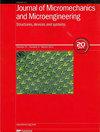Fabrication of ultra-low expansion glass based double paddle oscillator
IF 2.1
4区 工程技术
Q2 ENGINEERING, ELECTRICAL & ELECTRONIC
引用次数: 0
Abstract
Ultra-low expansion (ULE) glasses, with their excellent material properties like low thermal expansion coefficient (0.5 ppm K−1), are highly suitable for manufacturing micromechanical resonators. However, the lack of suitable microfabrication processes primarily limits the use of ULE glasses to macroscopic applications. This paper describes a detailed micro fabrication technique for producing double paddle oscillators (DPOs) using ULE glass substrates. We used a combination of low-pressure chemical vapor deposition (LPCVD), lithography, and wet etching techniques to manufacture millimeter sized mechanical oscillator with a thickness of 500 μm. We utilized a thick layer of LPCVD polysilicon (∼2.5 μm) as a hard mask for double side etching of thick ULE substrate. We were able to successfully identify different resonant modes of the DPOs using both electrostatic and optical detection methods. A laser Doppler vibrometer system was utilized to confirm different simulated resonant modes. Additionally, quality factor was extracted for different modes from ring down measurements for the first time in ULE based DPO.制造基于超低膨胀玻璃的双桨振荡器
超低膨胀(ULE)玻璃具有热膨胀系数低(0.5 ppm K-1)等优异的材料特性,非常适合制造微型机械谐振器。然而,由于缺乏合适的微制造工艺,ULE 玻璃的使用主要局限于宏观应用。本文介绍了使用 ULE 玻璃基底制造双桨振荡器 (DPO) 的详细微制造技术。我们结合使用了低压化学气相沉积(LPCVD)、光刻和湿法蚀刻技术,制造出厚度为 500 μm 的毫米级机械振荡器。我们利用一层厚厚的 LPCVD 多晶硅(2.5 μm)作为硬掩膜,对厚 ULE 基底进行双面蚀刻。我们利用静电和光学检测方法成功地识别了 DPO 的不同共振模式。我们利用激光多普勒测振仪系统确认了不同的模拟谐振模式。此外,我们还首次从基于 ULE 的 DPO 的环向下测量中提取了不同模式的品质因数。
本文章由计算机程序翻译,如有差异,请以英文原文为准。
求助全文
约1分钟内获得全文
求助全文
来源期刊

Journal of Micromechanics and Microengineering
工程技术-材料科学:综合
CiteScore
4.50
自引率
4.30%
发文量
136
审稿时长
2.8 months
期刊介绍:
Journal of Micromechanics and Microengineering (JMM) primarily covers experimental work, however relevant modelling papers are considered where supported by experimental data.
The journal is focussed on all aspects of:
-nano- and micro- mechanical systems
-nano- and micro- electomechanical systems
-nano- and micro- electrical and mechatronic systems
-nano- and micro- engineering
-nano- and micro- scale science
Please note that we do not publish materials papers with no obvious application or link to nano- or micro-engineering.
Below are some examples of the topics that are included within the scope of the journal:
-MEMS and NEMS:
Including sensors, optical MEMS/NEMS, RF MEMS/NEMS, etc.
-Fabrication techniques and manufacturing:
Including micromachining, etching, lithography, deposition, patterning, self-assembly, 3d printing, inkjet printing.
-Packaging and Integration technologies.
-Materials, testing, and reliability.
-Micro- and nano-fluidics:
Including optofluidics, acoustofluidics, droplets, microreactors, organ-on-a-chip.
-Lab-on-a-chip and micro- and nano-total analysis systems.
-Biomedical systems and devices:
Including bio MEMS, biosensors, assays, organ-on-a-chip, drug delivery, cells, biointerfaces.
-Energy and power:
Including power MEMS/NEMS, energy harvesters, actuators, microbatteries.
-Electronics:
Including flexible electronics, wearable electronics, interface electronics.
-Optical systems.
-Robotics.
 求助内容:
求助内容: 应助结果提醒方式:
应助结果提醒方式:


